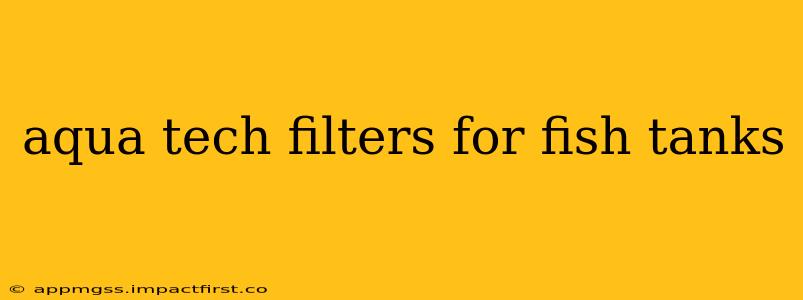Aqua Tech filters are a popular choice among aquarium enthusiasts, offering a range of solutions for keeping fish tanks clean and healthy. This comprehensive guide dives deep into the world of Aqua Tech filters, exploring their features, benefits, and how to choose the right one for your specific needs. We'll also address common questions and concerns surrounding these popular filters.
What are Aqua Tech Filters?
Aqua Tech manufactures a variety of aquarium filters, catering to different tank sizes and setups. They're known for offering a good balance of performance and affordability, making them a readily accessible option for both beginners and experienced aquarists. Their filter line includes hang-on-back (HOB) filters, canister filters, and even internal filters, providing versatile solutions for various tank environments.
What are the different types of Aqua Tech filters?
Aqua Tech offers several filter types to accommodate diverse aquarium setups. The most common are:
-
Hang-on-back (HOB) filters: These are compact filters that hang on the back of the tank, ideal for smaller to medium-sized aquariums. They're easy to install and maintain, making them a popular choice for beginners.
-
Canister filters: While Aqua Tech's canister filter offerings might be less extensive compared to their HOB filters, they provide superior filtration for larger tanks. These external filters offer powerful filtration, allowing for larger media volumes and more efficient waste removal.
-
Internal filters: These submerged filters are suitable for smaller tanks and offer basic filtration.
Which Aqua Tech filter is right for my tank?
Choosing the right Aqua Tech filter depends on several factors:
-
Tank size: This is the most crucial factor. Larger tanks require filters with higher flow rates and greater filtration capacity.
-
Stocking level: Heavily stocked tanks necessitate more powerful filtration to handle increased bioload.
-
Type of fish: Different fish species have varying waste production levels. More demanding fish require more robust filtration.
-
Budget: Aqua Tech offers a range of filters at different price points, allowing you to find a suitable option within your budget.
How do I clean an Aqua Tech filter?
Regular cleaning is essential for maintaining optimal filter performance and preventing harmful ammonia buildup. The cleaning process varies slightly depending on the filter type:
-
HOB filters: Rinse the filter media in old aquarium water, avoiding tap water, which contains chlorine and chloramine harmful to beneficial bacteria.
-
Canister filters: Similar to HOB filters, rinse the media in old tank water. For canister filters, you might need to replace certain media components more frequently than others.
Always remember to only clean a portion of the filter media at a time to prevent a complete loss of beneficial bacteria, vital for biological filtration.
How often should I replace the filter media in my Aqua Tech filter?
The frequency of filter media replacement depends on several factors, including the type of media, tank size, and stocking level. Generally, mechanical filter media (sponges, filter pads) should be replaced or cleaned every 2-4 weeks. Biological filter media (ceramic rings, bio balls) require less frequent replacement, typically every 6-12 months. Always consult your filter's specific instructions for the recommended replacement schedule.
Are Aqua Tech filters good for planted tanks?
Aqua Tech filters can be suitable for planted tanks, but you might need to consider a filter with a gentler flow rate to avoid uprooting delicate plants. Some aquarists modify their Aqua Tech filters or use additional measures to manage flow direction to protect plants.
Where can I buy Aqua Tech filters?
Aqua Tech filters are widely available online and at various pet stores specializing in aquariums. Check major online retailers and local fish stores to compare prices and availability.
This guide provides a comprehensive overview of Aqua Tech filters. Remember to always consult the specific instructions for your chosen filter model for detailed information on operation, maintenance, and troubleshooting. Happy fishkeeping!
